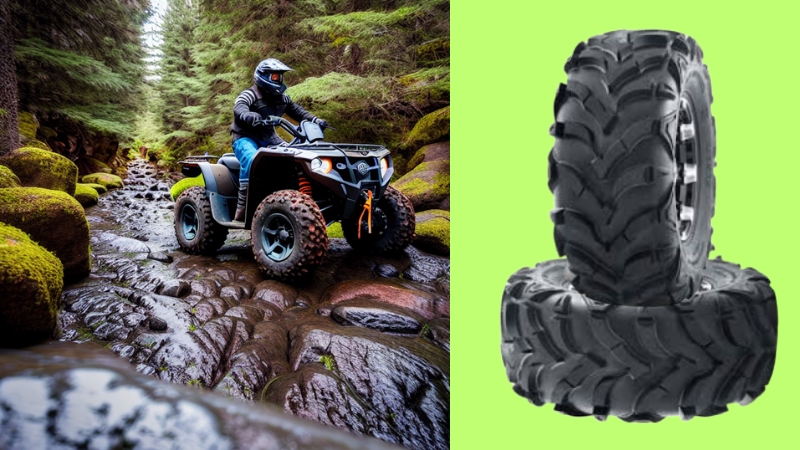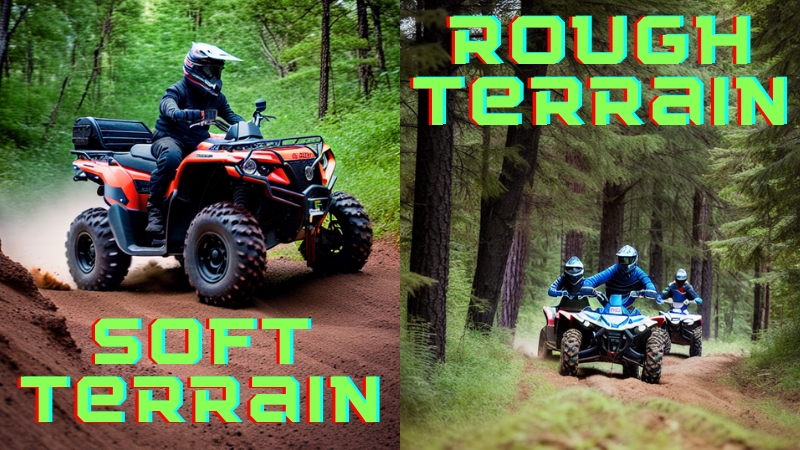2 Ply vs. 4 Ply ATV Tires, When choosing ATV tires, the ply rating is an important consideration besides finding suitable tire construction- radial or bias – for your needs. A tire’s ply rating indicates how many layers of rubber-coated fabric are used in its construction. A higher ply rating generally means a stronger, more durable, and higher load capacity tire.
2-ply and 4-ply ATV tires, the beginner ply numbers, differ in the number of layers of material used in their construction. 2 ply ATV tires are made with two layers of material, while 4 ply ATV tires have four layers. The extra layers in a 4 ply tire increase puncture resistance and durability, making them ideal for rugged terrain and heavy use. And the 2-ply tires are cheaper and lighter weight resulting in more speed.
However, it’s important to note that a higher ply rating doesn’t necessarily mean better performance in all situations. For example, 2 ply tires offer better traction on softer surfaces like sand or mud besides being lighter weight. Ultimately, the best choice will depend on your specific needs and intended use for your ATV.
Jump To Contents
2-ply ATV tires: Pros & Cons
2 ply ATV tires are lightweight and provide excellent traction on soft terrains at a lower cost. However, they are less durable and have a limited load capacity compared to four-ply options. These tires may also be unsuitable for all-terrain use due to their lightweight construction.

Lightweight: The primary benefit of 2-ply ATV tires is their lighter weight, which provides better speed and handling.
Better traction: They offer excellent traction on soft terrains like mud and sand due to their flexible sidewalls that conform to the ground surface.
Lower cost: They are less expensive than 4-ply ATV tires, making them an attractive option for buyers on a budget.
Less durable: Since these tires have fewer layers of material, they are more susceptible to punctures and cuts, leading to shorter lifespans.
Limited load capacity: Two-ply ATV tires cannot sustain heavy loads or rough terrain, as well as 4-ply options can.
Not suitable for all-terrain use: Due to their lightweight design, two-ply ATV tires may not be ideal for demanding off-road conditions such as rock crawling or aggressive trail riding.
4-ply ATV tires: Pros & Cons
Compared to the basic 2 ply tires, 4 ply ATV tires are both pricier and weightier. They do, however, offer more puncture resistance and protection against rough terrain, making them a prime choice for experienced riders who navigate rocky or muddy paths. Furthermore, their added layers of rubber grant improved stability during high-speed turns.

Improved Puncture Resistance: A 4-ply ATV tire has two additional layers of rubber and fabric compared to a 2-ply tire. This extra layering provides increased puncture resistance and durability.
Improved Handling: The added strength of a 4-ply tire makes it an ideal choice for rough terrain riding, as it can withstand sharper rocks, thorns, or other obstacles that a lighter tire might not handle.
Performance & Durability: If you are looking for enhanced performance and durability in extreme terrains, a 4-ply ATV tire is the right choice.
Load Capacity: Due to more layers of ropes, they can bear increased pressure from loading and inflation, leading to higher load capacity than their lower ply-rated counterparts.
Expensive: However, the downside of choosing a 4-ply ATV tire is that they tend to be more expensive than their 2-ply counterparts.
Slower Acceleration: The added weight can reduce your vehicle’s fuel efficiency and cause slower acceleration.
Stiffness: Furthermore, some riders may find the ride quality harsher with these tires due to their stiffness.
Other Crucial Factors to Consider
When it comes to choosing between 2-ply and 4-ply ATV tires, several other factors need to be considered.
Terrain: The first factor is the terrain on which the vehicle will be used. If the vehicle is going to be used on rough terrains such as rocky surfaces or steep hills, then a 4-ply tire would be more appropriate as they are designed for durability and strength over long periods of use. On top of ply rating, your target or preferred terrain and riding style have a say in determining your ATV tire size.
ATV Weight: Another important factor to consider is the weight of your ATV. Heavier ATVs require thicker and stronger tires to handle their weight effectively. Therefore, if your vehicle is heavy and large size, a 4-ply tire would be better suited for you. On the other hand, if your ATV is lighter in weight, then a 2-ply tire would suffice.
Value: Finally, value against investment is important to consider when making this decision. While 4-ply tires offer greater durability and strength at higher prices than their counterparts – the 2 ply vs 4 ply ATV tire cost may not always justify its value for someone who does not frequently ride through rough terrain or has heavier ATVs.
So, before deciding whether to go with a two-ply or four-ply tire for your ATV – one must analyze the type of terrain they will encounter while riding their vehicles along with their budget and overall usage pattern of their respective ATVs.
2 Ply vs. 4 Ply ATV Tires : Which Answers your needs better?
Choosing between 2-ply and 4-ply ATV tires ultimately depends on your needs and the terrain you will be riding on. So is the case when deciding on 4 ply and 6 ply ATV tire debate.
Drawing from the discussion above, 2-ply tires are generally lighter and more affordable, making them popular for casual riders who stick to smooth surfaces like roads or easy trails. However, they may not provide enough durability or traction for more intense off-road adventures.
On the other hand, 4-ply tires are heavier and more expensive than their 2-ply counterparts. They offer greater resistance to punctures and damage from rough terrain, making them ideal for serious riders who tackle rocky or muddy trails. Additionally, their extra layers of rubber provide better stability when turning at high speeds.
Consider your intended use for your ATV when deciding between 2 ply and 4 ply tires. If you plan on taking challenging paths regularly or hauling heavy loads as you do with your rocky mountain ATV or machines rolling over woods, investing in thicker tires can provide added protection and performance benefits. However, if you primarily ride on flat surfaces or want to save money upfront without sacrificing quality, 2 ply options may suit you just fine.

To say rephrasing, 4-ply tires are better than 2-ply tires because they offer greater durability and resistance to punctures. This is especially true for heavy-duty applications like off-road driving or hauling heavy loads.
One advantage of 4-ply tires is that they distribute weight more evenly across the tire surface, which can help prevent uneven wear and extend the tire’s life. They also tend to have thicker sidewalls, which provide additional protection against damage from rocks and other hazards on rough terrain.
However, it’s worth noting that not all 4 ply tires are created equal. Factors like tread design and rubber compound can also affect a tire’s performance and longevity. That is the case with 6 ply, 8 ply ATV tires and more.
Additionally, while 4-ply tires may be more durable overall, they also tend to be heavier than their 2-ply counterparts, which can impact fuel economy for some vehicles. Ultimately, choosing between a 2 or 4-ply tire will depend on your specific needs and usage habits as well as recommendations from your vehicle manufacturer or trusted mechanic.
Remember, ending up with the right ply rating or construction is half-done, as upgrading tires entails changing them without making any mistake.
FAQs
What is the difference between 2-ply and 4-plies?
The difference between 2-ply and 4 plies is primarily in the thickness and durability of the material. Ply refers to the number of layers used to create the paper product. Two-ply products have two layers, while four-ply products have four layers.
In general, 4-ply is thicker and more absorbent than 2-ply, making it a popular choice for high-traffic areas such as public restrooms or busy kitchens. However, because it is thicker, it may also be more expensive.
What is the highest ply in ATV tires?
The highest ply in ATV tires is typically 12. However, some manufacturers may offer tires with a higher ply rating.
ATV tires with a higher ply rating are generally more durable and capable of handling heavier loads. All the ply rating debate, 6 ply vs. 8 ply or 8 ply vs. 10 ply ATV tires, will give you the However, they can also be heavier and less flexible than lower-ply-rated tires, which can affect ride quality and performance.
Choosing an ATV tire with the appropriate ply rating for your specific needs and terrain is essential. Be sure to consult your owner’s manual or a trusted mechanic for guidance on selecting the right tire for your ATV.
Is 2 ply ATV tire thicker than 4 ply?
The ply rating of an ATV tire refers to the number of layers used in its construction. Generally, a higher ply rating means the tire is stronger and more durable. However, this does not necessarily mean that a 4-ply tire is thicker than a 2-ply tire.
The thickness of an ATV tire depends on various factors, such as the size, tread pattern, and material used. A 2-ply tire can be thicker than a 4-ply tire if it is made from more dense or heavy-duty materials. Similarly, manufacturers may use thinner materials in their 4-ply tires to reduce weight.
Is higher ply better ATV tire?
The higher the ply rating, the more layers are used in making the tire. However, it is not necessarily true that a higher ply rating automatically means better quality performance for your ATV.
When choosing an ATV tire based on its ply rating, it is crucial to take into account factors like weight and cost alongside other important parameters like tread design and compound composition, which will play an equal if not greater role in determining how well they perform across varying types of terrain conditions while remaining within budget constraints too.
Wrapping Up
Choosing between 2 plies and 4-ply ATV tires ultimately depends on the terrain you will be riding on and your preferences. If you are going to be mainly riding on pavement or flat surfaces, then 2 ply tires may suffice. However, if you plan on tackling rough terrains such as rocky trails or steep hills, then it is recommended to opt for 4-ply tires as they offer better protection against punctures.
This is, more or less, how to decide when favoring one between 8ply and 10 ply ATV tires.
Additionally, it is crucial to consider factors such as tire brand reputation and customer reviews before making a final decision. Investing in high-quality tires from reputable brands can save you money in the long run by reducing the need for frequent replacements. Yes, taking the time to research and make an informed choice when buying ATV tires can result in good riding experience while also ensuring safety and durability.